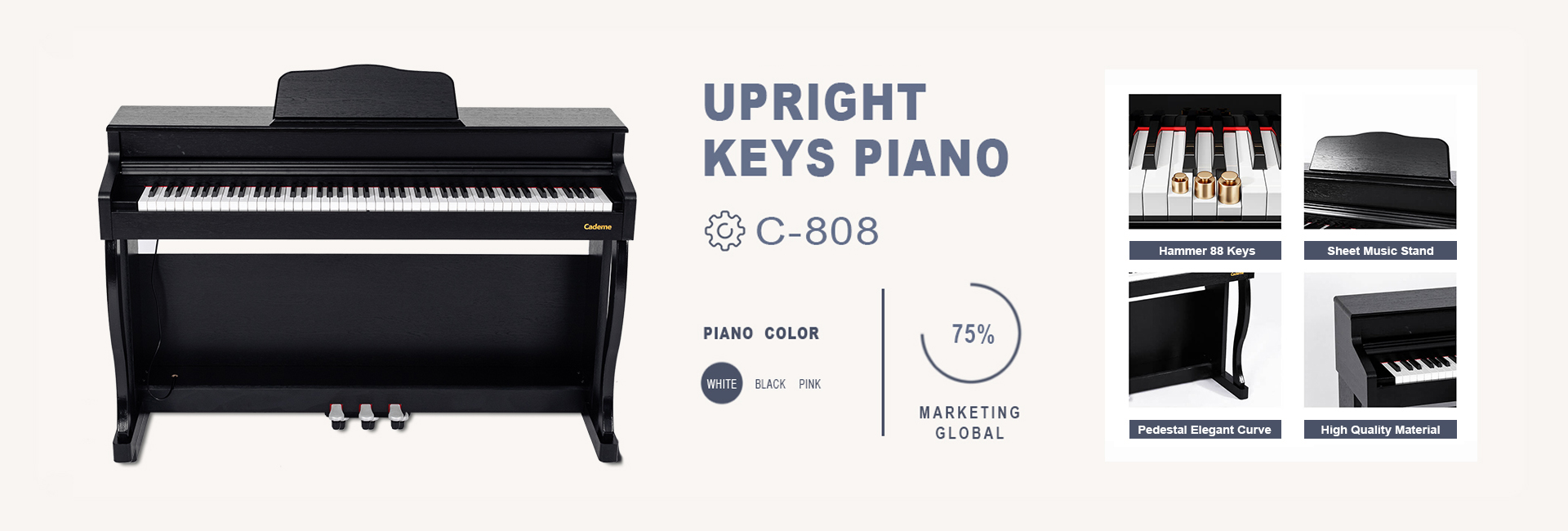- Introduction
- Definition of piano and guitar chords
- Importance of understanding chord structures
- Basic Differences Between Piano and Guitar Chords
- Formation on the instrument
- Number of fingers used
- Voicing and inversion options
- Similarities Between Piano and Guitar Chords
- Fundamental chord theory
- Major and minor chords
- Chord progressions
- Differences in Sound
- Timbre and tone
- Range and pitch variation
- Sustain and resonance
- Transposition and Adaptation
- Challenges in transposing chords
- Techniques for adapting chords between instruments
- Importance of ear training
- Notable Chord Variations
- Guitar-specific chords (e.g., power chords)
- Piano-specific chords (e.g., extended chords)
- Role in Music Composition
- Use of chords in songwriting
- Advantages and limitations on each instrument
- Collaborative possibilities between pianists and guitarists
- Learning Resources and Techniques
- Online tutorials and courses
- Practice exercises for chord mastery
- Importance of consistent practice and experimentation
- Conclusion
Are Piano and Guitar Chords the Same?
Give my new GPT a try: https://bit.ly/Jumma_GPTs
Piano and guitar, two of the most popular instruments in contemporary music, share many similarities but also possess distinct characteristics. One common question among musicians and enthusiasts is whether piano and guitar chords are the same. In this article, we delve into the nuances of chord structures on both instruments, exploring their similarities, differences, and implications for musicians.
Introduction
Understanding the fundamentals of piano and guitar chords is crucial for musicians of all levels. Chords, comprising three or more notes played simultaneously, form the harmonic foundation of music. However, the way chords are played and executed varies between the piano and guitar.
Basic Differences Between Piano and Guitar Chords
Formation on the Instrument
Piano chords are typically played by pressing multiple keys simultaneously, whereas guitar chords involve fretting specific combinations of strings with the fingers. The tactile approach differs significantly between the two instruments.
Number of Fingers Used
Pianists often use all five fingers to play chords, allowing for complex voicings and harmonies. In contrast, guitarists primarily use their fretting hand to form chords, with the strumming hand responsible for producing sound through picking or strumming.
Voicing and Inversion Options
Piano chords offer various voicing and inversion options due to the instrument’s linear layout of keys. Guitar chords, on the other hand, are limited by the fretboard’s vertical arrangement, although different fingerings and positions can produce alternative voicings.
Similarities Between Piano and Guitar Chords
Fundamental Chord Theory
Both piano and guitar chords adhere to fundamental music theory principles, including major and minor chord structures, intervals, and chord progressions. Understanding these principles is essential for constructing and interpreting chords on both instruments.
Major and Minor Chords
Both instruments can produce major and minor chords, which form the basis of most musical compositions. The tonal qualities of these chords contribute to the overall mood and emotion conveyed in a piece of music.
Chord Progressions
Chord progressions, sequences of chords played in succession, are ubiquitous in music across genres. Whether on piano or guitar, mastering common chord progressions is essential for songwriting, improvisation, and accompaniment.
Differences in Sound
Timbre and Tone
Piano chords exhibit a rich, resonant timbre characterized by the instrument’s percussive nature and sustain. In contrast, guitar chords produce a warmer, more organic tone influenced by factors such as string material, playing technique, and amplification.
Range and Pitch Variation
The piano offers a wide range of pitches across its keyboard, allowing for chord voicings spanning multiple octaves. Guitars have a narrower range but offer flexibility in pitch variation through alternate tunings and capo usage.
Sustain and Resonance
Piano chords sustain indefinitely until the keys are released, resulting in lush, sustained harmonies. Guitar chords, particularly acoustic ones, have a finite sustain influenced by factors such as string gauge, fretting technique, and resonance.
Transposition and Adaptation
Transposing chords between piano and guitar presents unique challenges due to differences in fingering, voicing, and range. However, with practice and ear training, musicians can develop strategies for adapting chords seamlessly between instruments.
Challenges in Transposing Chords
Transposing chords between piano and guitar requires understanding the unique characteristics of each instrument, including fingering patterns, chord shapes, and voicing preferences. Additionally, differences in range and timbre must be considered when adapting chords.
Techniques for Adapting Chords
Musicians can employ various techniques to adapt chords between piano and guitar, such as simplifying voicings, reinterpreting inversions, and adjusting octave placement. Experimentation and familiarity with both instruments enhance proficiency in transposition.
Importance of Ear Training
Developing a keen ear for pitch, harmony, and tonality is essential for accurately transposing chords between piano and guitar. Ear training exercises, such as chord recognition and interval identification, sharpen musicians’ ability to perceive and reproduce chord structures.
Notable Chord Variations
Both piano and guitar have unique chord variations that contribute to their respective sounds and playing styles.
Guitar-Specific Chords
Guitarists often utilize specialized chords such as power chords, barre chords, and open tunings to create distinctive sounds and textures. These chords are integral to various genres, including rock, blues, and folk music.
Piano-Specific Chords
Pianists frequently employ extended chords, such as seventh, ninth, and thirteenth chords, to enrich harmonies and add color to their compositions. These chords enhance the complexity and depth of piano music across genres.
Role in Music Composition
Understanding the differences and similarities between piano and guitar chords is paramount for composers and songwriters.
Use of Chords in Songwriting
Chords serve as the building blocks of music composition, providing harmonic structure and emotional resonance to songs. Whether on piano or guitar, composers leverage chords to convey mood, evoke emotion, and create memorable melodies.
Advantages and Limitations
Each instrument offers distinct advantages and limitations in chordal expression. Pianists have access to a wider range of chords and voicings, while guitarists benefit from the instrument’s portability and versatility in accompaniment.
Collaborative Possibilities
Collaboration between pianists and guitarists enriches musical arrangements by combining the unique timbres and textures of both instruments. Understanding chord structures on both piano and guitar facilitates seamless collaboration and creative synergy.
Learning Resources and Techniques
Numerous resources and techniques are available for aspiring musicians to improve their chordal proficiency on piano and guitar.
Online Tutorials and Courses
Platforms such as YouTube, Udemy, and Coursera offer a wealth of tutorials and courses covering chord theory, technique exercises, and practical applications. These resources cater to musicians of all skill levels and learning preferences.
Practice Exercises
Dedicated practice is essential for mastering chordal techniques on both piano and guitar. Structured exercises, such as chord progressions, arpeggios, and fingerpicking patterns, help develop muscle memory, dexterity, and fretboard awareness. Consistent practice routines tailored to individual goals accelerate skill development and proficiency.
Conclusion
In conclusion, while piano and guitar chords share fundamental principles of harmony and structure, they exhibit distinct characteristics in formation, sound, and application. Understanding these differences enhances musicians’ versatility, creativity, and collaborative potential. Whether composing, performing, or arranging music, proficiency in both piano and guitar chords empowers musicians to express themselves fully and engage audiences across genres and platforms.
Unique FAQs
- Are there any chords that are exclusive to either piano or guitar?
- While there are chords commonly associated with each instrument, such as power chords on guitar and extended chords on piano, there are no strictly exclusive chords. However, certain chord voicings may be more practical or idiomatic on one instrument compared to the other.
- How can I improve my chord transitions between piano and guitar?
- Practice is key. Start by mastering chord shapes and fingerings on each instrument individually, then gradually transition between chords smoothly. Focus on maintaining consistent rhythm and hand coordination to achieve fluid transitions.
- Can I use the same chord progressions for both piano and guitar compositions?
- Yes, many chord progressions are transferable between piano and guitar. However, consider the unique characteristics and timbres of each instrument when arranging or composing to optimize the musical impact.
- What role do chords play in improvisation on piano and guitar?
- Chords provide a harmonic framework for improvisation, allowing musicians to explore melodic variations and embellishments within a structured context. Understanding chord progressions and relationships is essential for improvisational fluency.
- Are there any specific techniques for embellishing chords on piano and guitar?
- Yes, both instruments offer various techniques for embellishing chords, including adding extensions, suspensions, and alterations. Experiment with chord inversions, arpeggios, and rhythmic patterns to enhance chordal textures and dynamics.





